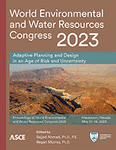Optimization of the Mixing in a Produced Water Storage Tank with CFD
Publication: World Environmental and Water Resources Congress 2023
ABSTRACT
In recent years, produced water recycling and reuse has been one of the most discussed topics in water treatment in the oil and gas industry. As with conventional wastewater treatment, some important processes of produced water treatment include filtration, solid content settling, oxidation, disinfection, and storage. As such, mixing efficiency is one of the important aspects when designing a treatment and recycling system. With the help of computational fluid dynamic (CFD) methods, the design and optimization of such systems becomes feasible by accurately simulating the hydraulic, mixing, and settling characteristics of a flow field. Through CFD analysis and system configuration optimization, the efficiency of the treatment process can be improved, which results in a reduction in operation costs. Artificial neural network (ANN) based metamodel is a mathematical simulation of a complex multi-dimensional system. To train such a model, a properly selected large-scale data set is required. However, these data would be both time and resource consuming to obtain with conventional physical experiments. With the help of CFD simulations, the data for the training process becomes easier to get from the virtual parametric study. As a set of mathematical equations, the developed ANN can provide a relative accurate prediction in a much shorter time, which will be a useful tool for the practical applications. This study explores the use of CFD modeling to simulate the mixing process in one of the most common water containing devices in Permian basins: above-ground storage tanks (AST). The first part of this study details how CFD, coupled with design of experiments methods (DOE) and post-processing automation, can quickly understand the relative importance and cross-correlations of various design elements to the mixing quality. The second part of the study introduces an artificial intelligence algorithm to the workflow to carry out an optimization of the AST tank design.
Get full access to this article
View all available purchase options and get full access to this chapter.
REFERENCES
Akaike, H. (1978). “On the likelihood of a time series model.” Statistician, 27, 19.
Anders, U., and Korn, O. (1999). “Model Selection in Neural Networks.” Neural Networks, 12, 15.
Barton, R. R. (1994). “Metamodeling: A state of the art review.” Simulation Conference Proceedings, 1994. WinterLake Buena Vista, FL, USA, 237–244.
Flow Science, Inc. FLOW-3D HYDRO 2022R2 User Manual, Santa Fe, NM,” Flow Science, Inc.”
Hopfield, J. J. (1988). “Artificial neural networks.” IEEE Circuits and Devices Magazine, 4(5), 3–10.
Hoque, S., Farouk, B., and Haas, C. N. (2011). “Development of metamodels for predicting aerosol dispersion in ventilated spaces.” Atmos Environ., 45, 12.
Hoque, S., Farouk, B., and Haas, C. N. (2011). “Development of Artificial Neural Network Based Metamodels for Inactivation of Anthrax Spores in Ventilated Spaces Using Computational Fluid Dynamics.” J Air Waste Manag Assoc., 61, 15.
Wang, G. G., and Shan, S. (2007). “Review of Metamodeling Techniques in Support of Engineering Design Optimization.” Trans. ASME, 370–380.
Wei, W., Farouk, B., and Haas, C. N. (2018). “Development of a CFD Based Artificial Neural Network Metamodel in Wastewater Disinfection Process with Peracetic Acid.” Journal of Environmental Engineering, 146(20).
Zhang, J., Tejada-Martínez, A. E., and Zhang, Q. (2014). “Developments in computational fluid dynamics-based modeling for disinfection technologies over the last two decades: A review.” Environmental Modelling & Software 58, 71–85.
Information & Authors
Information
Published In
History
Published online: May 18, 2023
ASCE Technical Topics:
- Artificial intelligence and machine learning
- Computational fluid dynamics technique
- Computer programming
- Computing in civil engineering
- Ecosystems
- Engineering fundamentals
- Environmental engineering
- Equipment and machinery
- Fluid dynamics
- Fluid mechanics
- Hydration
- Hydrologic engineering
- Laminating
- Materials engineering
- Materials processing
- Neural networks
- Storage tanks
- Tanks (by type)
- Water and water resources
- Water management
- Water reclamation
- Water storage
- Water supply
- Water supply systems
- Water tanks
- Water treatment
Authors
Metrics & Citations
Metrics
Citations
Download citation
If you have the appropriate software installed, you can download article citation data to the citation manager of your choice. Simply select your manager software from the list below and click Download.
